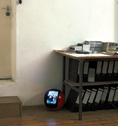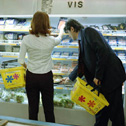The public sphere has been,
and still is, a reflection-or a narration, according to
Walter Grasskamp1 - of political wills, social fabric,
cultural dynamics and economic framework, as well as of
the reorganization and the expansion of our cities. In
this shared communal space, which is market place, site
of affirmation of power, of political and economical manifestations,
of religious commemoration and festive celebration, different
forms of everyday use converge and overlap.
In a time defined by the end
of ideologies, that comes together with the inability of
political and religious powers to define the notion of
the "public", public space has become a domain
of consumption. Shopping malls-where the commercialization
of goods and entertainment responds to a promise of experiences-- are
the substitutes of the traditional agora. In spite of their
apparent accessibility with their benches, walks and artificial
gardens, they are private spaces that establish their own
rules of access, surveillance and control.
This space discontinuity,
with the blur of the boundaries between private and public
life and the dispersion of the centers of production
and of images2 (the public spheres of industrialized
production3) define our contemporary experiences. This
fluidity of the limits is absolutely evident in the ambivalent
notion of space, defined by the technologies of information
and communication media. In this context, "place" becomes
a precarious concept and public sphere is transformed
into a "communicative spot" made of images
and representations, which are fixed in time and space
by the screen and linked to "real" and everyday
life. Privacy becomes, then, a guarantee of identity.
In addition, the exponential
growth of technology has led, in many areas of public
and private life, to a dual and simultaneous existence--digital
and real. The net brings also a new kind of ambiguity:
the net activity of individual participants in a publicly
accessible space, that is, a paradoxical longing for
anonymity and communication.
The project Revolving
Doors borrows its title from the renowned photograph
that shows the door in Marcel Duchamp's apartment in
Paris (1927), which opens a space and simultaneously
closes another one and its reverse. This image evokes
the notion of fluidity between the realms of the public
and the private, that this exhibition sets out to explore.
With their projects, the artists included in this show
present a wide range of approaches related to the ambiguity
and confusion between public sphere and private domain.
With their critical, ironic, poetic or subversive proposals,
they make statements or comments that alter the way
we view or think about reality. Although the approaches
can be very different, all the works have in common
the fact that they become very individual gestures
which define the relation of public/private in a human
scale. Eventually, it is the individual who makes the
door revolving.
Vito Acconci's Following
Piece documents a performance made by the artist
in 1969. In the course of the action, the artist followed
different people in the street. The action stopped
suddenly, each time the person entered a private space.
With this simple gesture, Acconci transcends the relativity
of the learned rules and behaviors concerning the distinction
between private and public.
Public Monument: Carlos (1998-99)
by Andreas M. Kaufmann, is a video shot on a busy
shopping street in Cologne in which we see a handicapped
person balancing a ball in the air using his crutches
and his head. Carlos, the main character of this video,
integrates himself in the public space by making an intelligent
use of his natural limits and the possibilities provided
by the site. Instead of giving the impression of begging,
he defines his own space and carries out an autonomous
and authentic formulation of his existence in the public.
In Gillian Wearing's
video Dancing in Peckham (1994), the artist dances
alone in the middle of a shopping mall, completely concentrated
on herself and ignoring the surrounding. In a time when
one can only be a user of public space by consuming,
Wearing's autistic dance becomes a real declaration of
the definition of the individual presence in the public,
completely detached from any consumer role.
Begoña Muñoz's
flyer and photographs document one of her "spontaneous
and not announced" performances. An intimate act--the
kiss--is celebrated in a social space, a cafe, as an
artistic statement. With the exclusive complicity of
the closest
friends of the artist, it evidences that private acts
can still find a secret place, in a subversive but friendly
way, in public space.
Christian Jankowski's Let's
get physical/digital (1997) questions in a playful
and unpredictable manner, the notions of time and space,
illusion and reality, distance and intimacy and, of
course, private and public. The starting point of the
project was a personal situation: the artist was in
Stockholm and his girlfriend in Milan. For seven days,
the couple communicated only through the Internet and
imagined their own meeting places in cyberspace. During
this time, the artist was searching the net for objects
to arrange in interiors where, later, actors recreated
his private dialogues. In a final twist, these performances
were recorded and the video was shown, again, on the
Internet.
Otto Berchem's projects
also require the involvement and the collaboration of
people in such a way that his proposals become on-going
social activities in which the artist becomes a catalyst. The
Dating Market (2000-01) focuses on inter-human relations
in contemporary society. The visit to the local supermarket
after work that Berchem defines as "the latest spin
on a singles bar" becomes the core of the project.
Components of the project are presented in the exhibition
space and in a real supermarket, where a series of shopping
baskets with a flower motif, derived from the stage set
of the 70s TV program "The Dating Game", are
offered to the customers who want to label him- or herself
as "available".
Mark Formanek's Archive
of 100 Statements was started in 1991 and has since
then continually endeavored to increase in size. A
time limit for the archive has not been set. It consists
of a preserved collection of statements from individuals
with 100 remarks (c/o Mark Formanek, Schmale Strasse
26, D- 48149 Münster) that are presented without any
kind of censorship, translation or editing. The statements
offer a variety of real and authentic "portraits",
absolutely anonymous, that communicate a mixture of
deep thoughts and banal ideas that draw an image of
the personality of the contributors.
When a visitor enters www.aleph-arts.org/1.000.000,
the computer screen literally becomes invaded by a million
kisses that behave like an uncontrollable virus. With
a playful but absolutely critical attitude, Antoni
Abad subverts the codes of some communication devices
we are accustomed to: the promises of sex or love in
exchange for a universal password-our credit card number.
Instead of referring to an amount of money, as might
be predictable, the title 1.000.000 (1999) quantifies
the number of kisses the visitor receives. In this way,
Abad makes a playful but strong comment to the mercantilist
and aggressive vision that involves pornography on the
Internet.
In Personal/Public (1979),
by Antoni Muntadas, the juxtaposition/contrast
of two screens, one of them tuned to a television channel,
and the other returning the viewer's image by means of
a surveillance camera, becomes an appropriate comment
to the process of personal information (the individual)
turning into public through the media and, its reverse,
public information becoming personal through individual
reception and interpretation.
The strategies of commercials
are used by Roland Boden to present the Urban
Shelter Units, "the innovative solution in personal
combination shelters, a modular system to improve passive
safety measures in private and public space". As
the brochure of this "product" announces, "civil
war, disorder, criminality, vandalism and troubles, conflicts
among neighbors and in the family are increasingly endangering
society's peaceful coexistence". In this context,
the Urban Shelter Units system not only promises to
satisfy our desires for individual solutions, according
to our situations and requirements, but also to re-configure
our domestic environment.
Montse Badia
© September 2001
1. Grasskamp,
Walter, "Art in the city", in Sculpture
Projects in Münster, 1997 (catalogue) Gerd Hatje
Ed., Münster, 1997 (p. 7)
2. Rosler, Martha, If you Lived Here. The City in Art, Theory and Social
Activism. A Project by Martha Rosler, Bay Press and Dia Art Foundation,
Seattle and New York, 1991 (p. 20).
3. According to the definition by Alexander Kluge and Oskar Negt, "The
Public Sphere and Experience", in October # 46, MIT, Massachusetts,
fall 1998 (p. 66).



Otto Berchem Dating
Market, 1999-2001
Christian Jankowski Let's get physical/digital, 1997/2000
Andreas M. Kaufmann Public Monument: Carlos, 1998-99
PRESS RELEASE
The project Revolving Doors borrows its title from the renowned photograph
that shows the door in Marcel Duchamp's apartment in Paris (1927), which
opens a space and simultaneously closes another one and its reverse. This
image evokes the notion of fluidity between the realms of the public and
the private, that this exhibition sets out to explore.
The list of
participants in Revolving Doors include artists
from different generations that in different contexts
and time have approached these issues. With their projects,
the artists present a wide range of approaches related
to the ambiguity and confusion between public sphere
and private domain such as the analysis of individual
and communal behaviors in public spaces (Vito Acconci),
the definition of the own personal space in the public
(Andreas M. Kaufmann, Gillian Wearing), a "subversive" and
secret use of the public space (Begoña Muñoz),
the projection of a created privacy into the public (Christian
Jankowski), the creation of relational spaces (Otto Berchem),
the different ways of presenting the individual in the
public (Mark Formanek), the commercialization of the
private through Internet (Antoni Abad), the subjective
perception of the media and its reverse (Antoni Muntadas)
and the advertising promises for the redesigning of the
public space (Roland Boden).
With their critical,
ironic, poetic or subversive proposals, all these projects
make statements or comments that alter the way we view
or think reality. Although the approaches can be very
different, all the works have in common the fact that
they become very individual gestures which define the
relation public/private in a human scale. Eventually,
it is the individual who makes the door revolving.
A color brochure
containing an essay by Montse Badia will be available
free of charge. Please contact apexart for further
information.
Hours are Tuesday to Saturday, 11-6.

